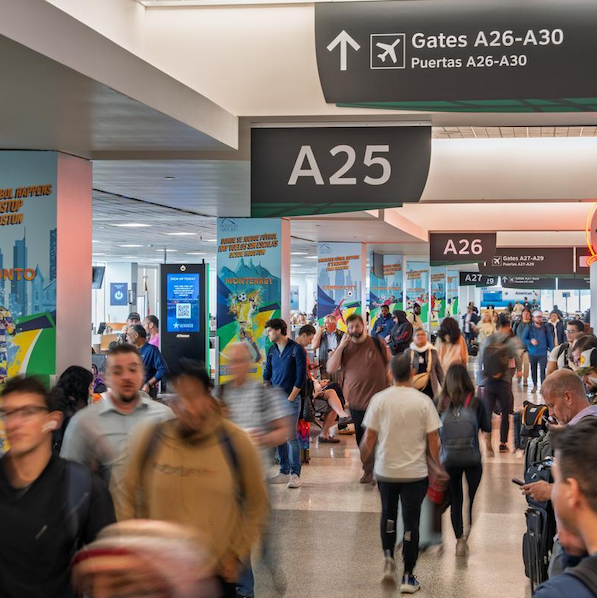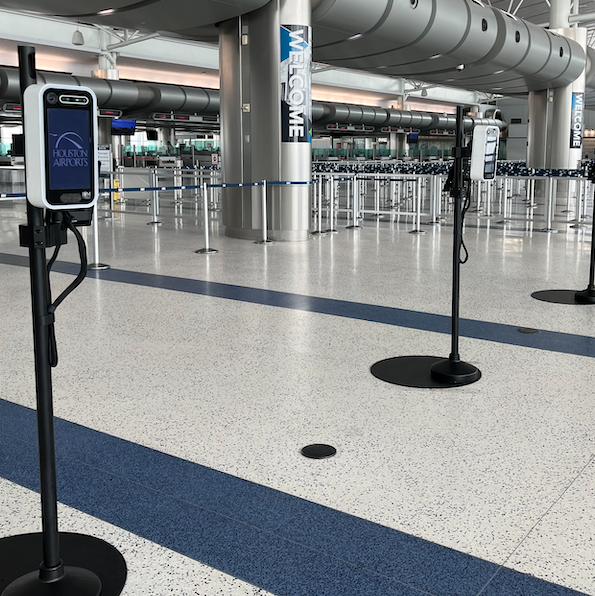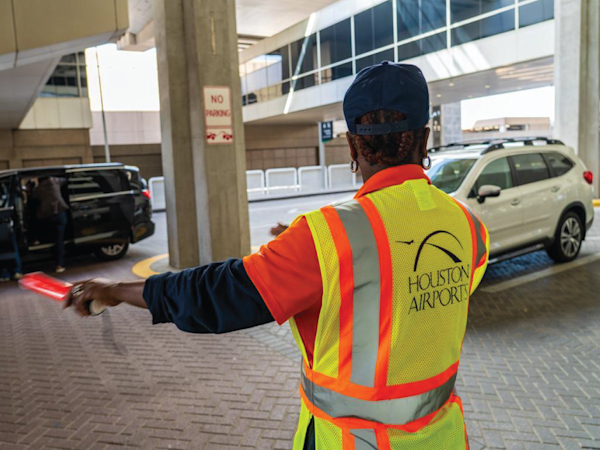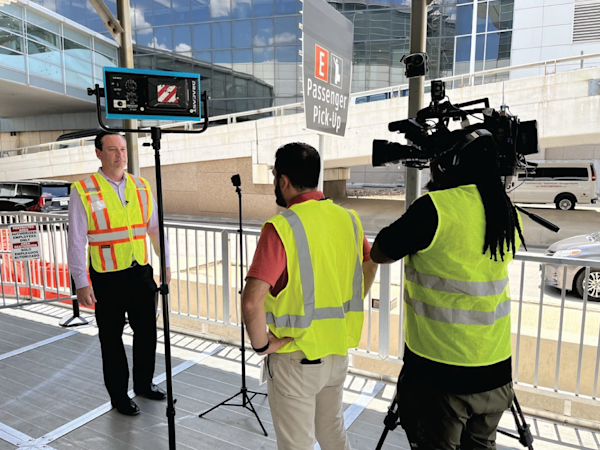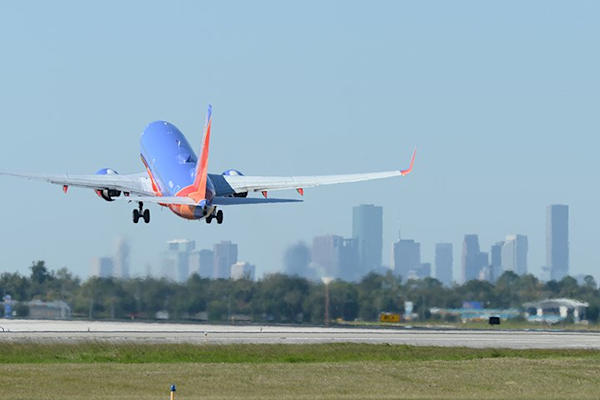Top Story
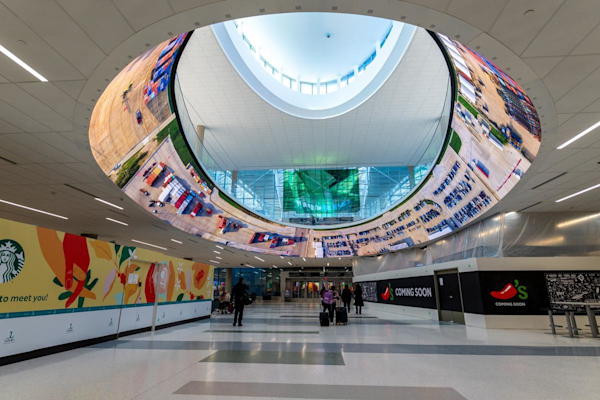
Top Story
2025: A year of transformation at Houston Airports
Houston Airports spent 2025 doing what airports rarely get credit for — improving almost everything at once. Across George Bush Intercontinental Airport (IAH), William P. Hobby Airport (HOU), and Ellington Airport (EFD), progress was evident in new infrastructure, advanced technology, streamlined operations and a renewed focus on delivering a more predictable and Houston-friendly passenger experience. It was a year defined not by one project or one achievement, but by a steady, systemwide lift that touched nearly every part of the organization.
 A look at the new women's restrooms in Baggage Claim at HOU.
A look at the new women's restrooms in Baggage Claim at HOU.
This was a year of construction cranes and glass installations, of polished floors and new terminal spaces, of a reorganized workforce and a reenergized mission. It was a year when Houston Airports solved real problems — from traffic congestion to outdated technology — and delivered improvements the public could see and feel.
 A look at IAH Terminal D Departures, with all lanes reopened after construction.
A look at IAH Terminal D Departures, with all lanes reopened after construction.
And it was a year that set the foundation for something larger: preparing Houston to welcome the world in 2026.
A modern airport experience takes shape
The most visible change came with the opening of the first phase of the International Central Processor (ICP) at IAH, the largest modernization project in the airport’s history. For the first time since 2021, international passengers stepped into a new Terminal E Ticketing Lobby — brighter, more intuitive and designed to support Houston’s status as a global gateway.
RELATED | Visible progress defines the IAH Terminal B Transformation
Nearby, the long-anticipated Oculus came online, bringing new digital connectivity and real-time visual intelligence to airport operations. Wi-Fi 6 deployment across terminals further strengthened the digital backbone that millions of passengers rely on every year.

At HOU, the $470 million West Concourse expansion continued climbing skyward, marked by a December topping-off ceremony that honored the tradespeople building the next era of the airport.
 A view of the HOU West Concourse, which is being expanded to include 7 additional gates.
A view of the HOU West Concourse, which is being expanded to include 7 additional gates.
Behind the walls, Houston’s maintenance crews regrooved runways, modernized restrooms and kept aging infrastructure running smoothly while new infrastructure rose beside it. The team’s transition to a chemical-free diamond pad floor-polishing system brightened more than 800,000 square feet of terminal flooring and delivered significant cost savings — a small change with a big impact.
 Before/After of diamond pad floor polishing at IAH.
Before/After of diamond pad floor polishing at IAH.
Technology that changes the passenger journey
Houston Airports is evolving into one of the nation's most technologically advanced airport systems.
2025 saw the debut of:
- CLEAR’s new automated eGates at both IAH and HOU
- Enhanced Passenger Processing (EPP) with CBP, adding a new option for expedited international arrivals
- A redesigned, mobile-first Fly2Houston.com
- A more intuitive Houston Airports mobile app
- A new parking system with improved reservations and guidance
- A new concessions rewards program
- A more unified Airport Insider internal storytelling platform
EXPLORE | Houston Airports on YouTube
Each of these upgrades did more than modernize the airport system. They made the passenger journey more predictable, more efficient and more Houston-friendly.
Traffic improved. Flow restored. Confidence earned.
One of the year’s most meaningful milestones wasn’t a construction opening — it was a traffic improvement.
Working alongside the City of Houston, Houston Airports eased long-standing roadway chokepoints at IAH, clearing arrivals and departures faster, reducing congestion and delivering on Mayor John Whitmire’s priority for a more functional, user-friendly airport.
The change was unmistakable. Passenger satisfaction climbed. Complaints dropped. And confidence in the system grew.
 A view of IAH Terminal A
A view of IAH Terminal A
This improvement — delivered through engineering, coordination and disciplined execution — set the tone for the year: Houston Airports listens, responds and delivers results.
Investments in hospitality and people
Houston-friendly hospitality remained the heart of the organization’s work. Terminal Operations teams supported record holiday and spring break travel. Therapy dogs comforted thousands — from everyday travelers to children departing on the Snowball Express. Volunteers and ambassadors expanded their presence. And staff across every division — custodial, maintenance, IT, operations, public safety, commercial development and more — carried the airport’s reputation forward.
Houston Airports also reorganized its internal structure to operate more efficiently, merging key functions and supporting career growth. Employees advanced, divisions strengthened and a renewed sense of mission took hold.
 A look at the Houston Airports Infrastructure Division in the new team uniform.
A look at the Houston Airports Infrastructure Division in the new team uniform.
That mission — to connect the people, businesses and cultures of the world to Houston — became sharper this year. So did the vision: to become a premier global air service gateway and the actively preferred choice for connecting passengers.
The art, culture and personality of Houston take center stage
Houston Airports continued to lead the world with the World’s Best Airport Art Program, adding major new installations and celebrating 10 years of Harmony in the Air.
From large-scale commissions to the rotating Art Car exhibit to the expanded public music program, Houston Airports made travel feel more human — and more distinctly Houston.
Beyoncé Cowboy Corner at Bush and Hobby airports became an unforgettable moment of hometown pride, and thousands of travelers stopped to photograph it.
Aviation excellence across three airports
This year, Houston Airports:
- Maintained 4-Star and 5-Star Skytrax ratings
- Earned flawless 2025 FAA safety inspections at HOU and EFD
- Welcomed new air service, including ZIPAIR to Tokyo
- Hosted hundreds of thousands of business travelers, sports fans and convention attendees
Looking ahead to 2026
If 2025 was the year Houston Airports rebuilt, refined and reset, then 2026 will be the year it rises to global attention.
The FIFA World Cup will bring millions of new travelers to the region. Houston Airports will meet that moment with stronger infrastructure, modern technology and improved passenger flow.
 A view of IAH Terminal A and the Houston Airports marketing campaign for the World Cup.
A view of IAH Terminal A and the Houston Airports marketing campaign for the World Cup.
RELATED | One terminal. One clock. One unforgettable kickoff to the 2026 World Cup
Houston Airports is ready — not by chance, but by the work of thousands of people who showed up every day in 2025 to polish floors, fix systems, guide planes, launch technology, support passengers and represent Houston with pride. 2025 was a year of movement.
2026 will be a year of momentum.



